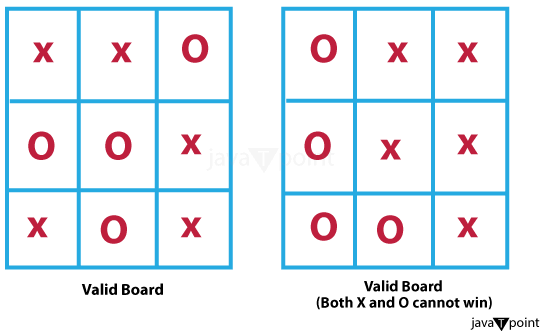Validity of a given Tic-Tac-Toe board configurationTic-Tac-Toe, a traditional game enjoyed by millions throughout the world, is not only a source of enjoyment but also a source of academic inquiry. Because of the game's simplicity, it's an excellent instance for researching board layouts and their validity. In this post, we will look at a valid Tic-Tac-Toe board configuration and how to tell if a particular board follows the game's rules. Valid vs. Invalid Board ConfigurationsA valid Tic-Tac-Toe board layout follows the game's specified rules. It is critical to examine the following major elements when determining the authenticity of a particular board: Number of Xs and Os: The number of Xs and Os in an acceptable configuration should be nearly equal, with X generally making the initial move. If one of the players wins the game, they usually get one more move, which is absolutely fine. Unoccupied Cells: A valid configuration must not have any cells with two marks, i.e., an X and an O in the same cell. Without exception, all markers on the board should be singles. Winning Condition: A valid configuration must correspond to the Tic-Tac-Toe winning condition. If a player has already won, the board should show a legitimate winning pattern, such as a row, column, or diagonal, and the game should end there. Game Progression: The sequence of moves should adhere to the game's turn-based structure. For example, X cannot make two consecutive movements unless O takes a turn in between. Game completion: If the board is full and no one has won, the game should end in a draw. There should be no more possible movements, and neither player should have established a winning pattern. 
Algorithm1. Starting the Game:
2. Show the Board:
3. Gameplay Loop:
Look for a winning condition:
Check for a draw:
Request a move from the present player:
Verify the move:
4. The game is over:
RulesObjective: Tic-Tac-Toe's goal is for the first player to build a row, column, or diagonal of three of your symbols (either X or O) on a 3x3 grid or board. Equipment: To play Tic-Tac-Toe, you'll need a 3x3 grid, generally created on paper or a gaming board, and two players, one with the X sign and the other with the O symbol. Gameplay: Starting Player: X is the typical starter. Players take turns inserting their emblem on an empty grid cell. Turn-based: Players take turns and make one move per turn. The initial move is made by X, followed by O, and so on. Winning Condition: The first person to produce a horizontal, vertical, or diagonal line of three of their symbols wins the game. When a winning pattern is achieved, the game is over. Draw (Tie): The game is called a draw (tie) if all of the cells on the grid are filled, and no player has established a winning pattern. The game is over, and no one has won. Illegal movements: Players are not permitted to place their symbol in a cell that is already held by the symbol of their opponent, nor can they make two consecutive movements. Patterns of Success: Horizontal: Three of the same sign on the same horizontal line in a row. Vertical: Three identical symbols in a row on the same vertical line. Diagonal: Three of the same symbol diagonally from the top-left corner to the bottom-right corner or top-right corner to the bottom-left corner. The game is over: When one player achieves a winning pattern, or when all cells on the grid are filled, the game ends in a tie. Validity EvaluationTo determine the legitimacy of a specific Tic-Tac-Toe board arrangement, do the following steps:
ImplementationOutput:
Welcome to Tic-Tac-Toe!
| |
---|---|---
| |
---|---|---
| |
Player X's turn.
Enter your move (row and column, e.g., 1 2): 1 1
X | |
---|---|---
| |
---|---|---
| |
Player O's turn.
Enter your move (row and column, e.g., 1 2): 2 2
X | |
---|---|---
| O |
---|---|---
| |
Player X's turn.
Enter your move (row and column, e.g., 1 2): 1 2
X | X |
---|---|---
| O |
---|---|---
| |
Player O's turn.
Enter your move (row and column, e.g., 1 2): 2 1
X | X |
---|---|---
O | O |
---|---|---
| |
Player X's turn.
Enter your move (row and column, e.g., 1 2): 3 3
X | X | X
--|---|---
O | O |
---|---|---
| |
Player X wins!
Next TopicWeighted Prefix Search
|
 For Videos Join Our Youtube Channel: Join Now
For Videos Join Our Youtube Channel: Join Now
Feedback
- Send your Feedback to [email protected]
Help Others, Please Share










